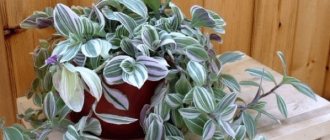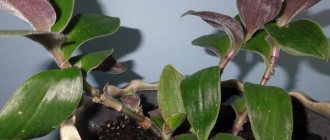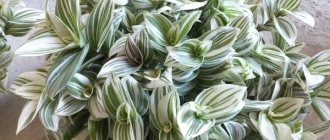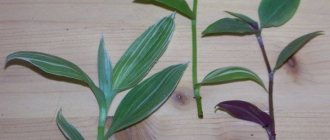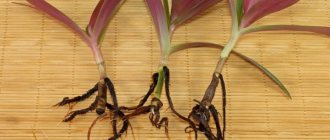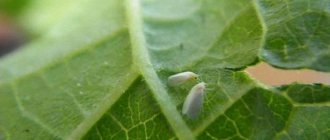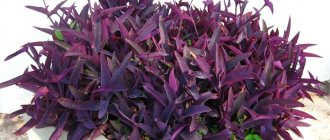Plants » Flowers
0
233
Article rating
Kira Stoletova
Tradescantia variegated is a perennial herbaceous plant from the genus of the same name. Flower growers have retained the former name Reo veil, derived from the name of a mythological character - a nymph. Native to the subtropical zones of Mexico and America. Widely cultivated in private gardening.
Tradescantia variegated is a wild plant.
Botanical characteristics
Tradescantia Reo is a herbaceous plant formerly part of the Commelinaceae family. In the natural environment, the wild crop is found in tropical forest belts, on the banks of natural reservoirs and sometimes grows on rocky slopes.
The decorative effect of the flower is provided by bright foliage, which can be plain green or purple, with a striped pattern of different shades, including white, pink and yellow.
Description:
- the stem is erect, the structure is fleshy, height up to 0.4 m, with numerous branches growing in random order, often under the weight of large foliage and in combination with lateral lighting they take on a hanging shape;
- leaves from 0.2 m long or more, about 6-8 cm wide, lanceolate in shape, horizontally directed, sessile position, elastic structure, glossy surface, the color of the upper part of the leaf blade is often dark green, the inner one is red-violet, present on the foliage striped ornament, on the surface there is orange and red hairy pubescence, the lower tier falls off as the plant grows, turning Tradescantia into a palm tree, resembling dracaena in appearance;
- the root system is fibrous, with thin villi roots;
- the inflorescences are small, white in color, attached to short pedicels, closed in a boat-like blanket, consisting of two or three leaves of a violet-colored bract.
With a properly organized microclimate, flowering is observed in any season throughout the entire calendar year, but in most cases it occurs in mid-summer.
Tradescantia variegated (Tradescantia capella, Reo, Moses' Rook)
Tradescantia variegated was classified as a species of the genus Tradescantia relatively recently. Previously, due to its small external resemblance to other Tradescantia, it was classified as a separate genus of the Commelinaceae family - Reo.
This name was given to the plant in honor of the mythical beloved of the ancient Greek god Apollo.
In its shape and color, Tradescantia variegated is somewhat similar to a miniature Dracaena.
Growth:
In nature, Tradescantia variegated is common in the Antilles, Central America and Mexico.
IN THE PHOTO: Multi-colored Tradescantia in its natural environment.
The decorative nature, compactness and unpretentiousness of the plant made it a popular decoration for greenhouses, winter gardens, and later for halls and offices.
Description of the plant:
Plant size and type:
The height of the herbaceous perennial in cultivation rarely exceeds 40 cm. Its branches can be arranged on the stem in any order, thereby creating a natural, original shape of the plant.
As Tradescantia epilate grows older, the heavy lower leaves may fall off, giving it a slight Palm-like appearance. The entire plant is covered with short red-orange “hairs”, giving it a special decorative appearance.
Root system:
The root system is typical for geophyte plants, fibrous with fine hairs.
Stem:
Thick, “meaty”.
Leaves:
Lanceolate, arrangement on the stem is “sessile”, horizontal. The leaf width is usually 5–8 cm, the length is up to 30 cm. The color of the leaves is unusual: they are dark green at the top, purple-red at the bottom, with visible stripes.
IN THE PHOTO: Leaves are the most decorative part of Tradescantia variegated.
Flowers:
The inflorescences of Tradescantia variegated are small, covered with large boat-shaped “spreads” of two violet or purple bracts. Flower color is white.
IN THE PHOTO: Inflorescences of Tradescantia capillata.
Flowering is short-lived and can begin at any time of the year. The main condition for the beginning of the flowering of Tradescantia variegated is a sufficient amount of sunlight.
Root system:
It is quite weak, so plants, especially young ones, should be replanted very carefully and not allow the soil to dry out.
Popular varieties:
The most famous varieties of Tradescantia variegated in Russia:
- low growing violet-green 'Compacta';
- 'Stripe in Pink' with an interesting pink underside of the leaves and white-pink stripes on the front side of the leaf blade;
- 'Vittata', the leaves of which are impressively decorated with yellow stripes.
IN THE PHOTO: The green-yellow-purple color of the 'Vittata' variety looks very elegant.
Agricultural technology:
Temperature:
The optimal temperature for keeping Tradescantia variegated is from +18°C to +22°C, although it can tolerate higher temperatures quite well.
During the cold season, the air temperature in the room with Tradescantia should not be lower than +10–16°C. A sudden cold snap can cause a loss of turgor in the leaves of the plant.
Lighting:
The plant is light-loving, but its long exposure to direct sunlight can cause leaf burns. It is better if the light is diffused. For a full growing season, Tradescantia variegated needs 8–10 hours of daylight.
This species does not tolerate relocation relative to the light source very well, so it is worth choosing a suitable place for Tradescantia initially.
Watering and air humidity:
Tradescantia multicolored should be watered moderately, about twice a week in warm weather and a maximum of three times a month in cold weather. In the summer heat, watering is increased as needed to prevent the soil from drying out.
Since the plant comes from the tropics, it needs air humidity of at least 70–75% and daily spraying of the leaves. If the air humidity drops to 60%, Tradescantia may be affected by spider mites.
Fertilizer:
Tradescantia variegated is suitable for complex fertilizing for indoor decorative foliage plants (read more about them in our article “Types of fertilizers and their features”). Fertilizers are applied every two weeks from early spring to late summer.
Substrate:
Neutral soils (pH 6.0–7.0) and slightly acidic (pH 5.0–6.0) are preferred. The optimal soil composition for Tradescantia variegated is sand, leaf soil and turf in a ratio of 1:3:1. Good drainage is required.
Transfer:
Young plants need to be replanted annually, mature plants - usually once every few years, into pots of appropriate size.
Rest period:
Lasts from October to February, when light and air humidity are low.
Trimming:
Dry leaves and flowers are removed regularly.
IN THE PHOTO: Constant correction of the shape of Tradescantia multicolored is the key to its impeccable appearance.
Pests and diseases:
Reo is little exposed to diseases and pest attacks, but sometimes scale insects appear on plants. To protect indoor Tradescantia from harmful insects, you can treat it with Aktara, Biotlin, Aktellik.
Plants can suffer from fungal diseases, such as powdery mildew and gray mold. The fungicides Topaz and Fundazol can help prevent them. Watering too much can cause leaf rot. Normalizing the watering regime and removing damaged areas help stop rotting and maintain the health of Tradescantia variegated.
When caring, you must take precautions: Tradescantia variegated juice can cause contact dermatitis.
Reproduction:
Propagated by rooting side shoots, dividing the bush, and seeds (much less often).
Tradescantia variegated is actively growing and requires timely removal of the “babies”. By planting them, you can create a beautiful “carpet” of unusual exotic Tradescantia.
In the PHOTO: A “carpet” of multi-colored Tradescantia will decorate any garden or greenhouse.
Editorial team LePlants.ru
Purchase and adaptation
The best time to buy a home flower is spring. Before the onset of the cold season, he will have time to adapt to new conditions.
Tradescantia variegated wild growing
When purchasing, you should pay attention to the appearance of the plant. In a healthy Tradescantia:
- bright rich color corresponding to the variety;
- there are no spots or signs of pests on the leaves;
- root system without damage.
Price - from 500 rubles.
Immediately after purchase, the flower crop is placed in quarantine, isolating it from other domestic flowers. In 2 weeks the plant undergoes adaptation, and during this time it is not replanted or fed.
Growing conditions
A sunny place is suitable for planting. Flower culture is intensively developing on the eastern and western sides of the room. When located in the north, it needs additional lighting; when placed in the south, shading during solar hours.
The capillary variety does not tolerate relocation well, so a permanent place of growth for it is chosen immediately.
For the full development of an indoor flower, a ready-made slightly acidic or acid-neutral substrate intended for growing decorative deciduous plants is suitable.
You can make the soil yourself by mixing fertile garden soil, peat mixture and river sand in proportions 5:3:2. To increase the aeration of the soil mixture, agroperlite or agrovermiculite is added.
Flower culture needs good drainage. Requires high humidity, at a level of 70-75%, and responds well to foliar spraying.
Temperature
Optimal mode:
- in summer - about 25°C;
- in winter - not lower than 10°C.
When grown on balconies and in open conditions, Tradescantia can withstand short-term temperature drops of up to 5°C, but such a drop causes the leaves to lose turgor. Does not tolerate drafts well.
Lighting
The flower is susceptible to prolonged exposure to the sun. Requires diffused light and shading from aggressive rays in order to prevent burns of the vegetative mass.
With a lack of lighting, it begins to stretch and changes the color of the leaves to pale. The optimal length of daylight is 8 hours or more. In winter, the lack of light is compensated by the use of artificial sources - fluorescent lamps.
Care
Planting and transplanting
For planting Tradescantia, in which the roots develop in diametrically opposite directions, a wide and not very deep pot is more suitable. Before filling the container with substrate, drainage from construction expanded clay or broken brick is laid on the bottom.
5 Tradescantia variegated
- The young plant is replanted annually, replacing the soil by 1/3;
- For an adult, a transplant every 3-4 years is sufficient.
The most suitable method is transshipment. The best time is from spring to early summer.
Watering
Tradescantia is unpretentious to watering, copes with short-term drought, but is susceptible to prolonged drying out of the soil.
Optimal watering regime:
- in spring and summer, at the stage of active vegetation, the flower crop is watered at intervals of up to 2-3 times a week, as the surface layer of the substrate dries 3-5 cm;
- in winter, combined with low temperatures, watering is reduced to 1-3 times a month.
Feeding
Homemade Tradescantia is fed in spring and summer, from March to August. Ready-made fertilizers designed for decorative indoor flowers are suitable for feeding. The frequency of application is once every 2 weeks.
Trimming
No formation required. Dry leaves and dried inflorescences must be pruned. Regular pinching of shoots will help ensure splendor and wide development of the flower crop.
How to care for Tradescantia reo at home
The plant is unpretentious in care and undemanding in terms of keeping conditions; even novice gardeners can grow reo.
Choice of location and lighting
The best place for the plant will be windows facing west and east. Bright lighting is required, but avoid direct sunlight. In winter, when the sun is less active, it can be placed on south-facing windows. Due to lack of light, the plant becomes stretched and the color fades.
Air temperature
In the spring-summer season, maintain the air temperature at 20° C, in autumn and winter - at least 15° C. Avoid sudden temperature changes and drafts.
Watering and spraying
In summer it is necessary to water abundantly and regularly. Reduce watering as autumn approaches.
Spray frequently, especially in winter, when the air becomes dry due to heating systems. Sometimes place the plant pot on a tray of damp moss or pebbles.
For watering and spraying, use softened water at room temperature.
In the summer, you expose the pot with the plant to fresh air, you can even plant it in open ground.
Priming
The plant needs light, loose soil. You can purchase a ready-made mixture intended for decorative foliage plants at a flower shop. The following soil mixture is also suitable: mix clay-turf soil, leaf soil, peat soil, coarse sand and humus in equal proportions. Since the plant needs frequent watering, it is recommended to pre-treat the soil with a fungicide to prevent the appearance of rot in the future.
Feeding
In spring and summer, mineral fertilizers must be applied every two weeks. With the onset of autumn, feeding is stopped.
Transfer
How to transplant Tradescantia reo photo
- Young plants require annual replanting. Adult specimens are replanted every 3-4 years. Replant in the spring, maximum in early summer.
- The root system of the plant develops more in width, so choose an appropriate container: wide and not deep, each time increase the width of the pot by a few cm from the previous one.
- Be sure to lay drainage at the bottom of the container, with a small layer of earth on top (5-6 cm).
- Carry out the replanting using the transshipment method: water the flower, let the roots and soil become damp, so that you can easily remove the pot from the earthen ball. They try not to damage the roots; they simply transfer the flower with a lump of earth to a new pot and add soil to the sides.
How to plant reo
During transplantation, the bush can be divided either in half or generally into many separate divisions, preserving part of the root system and at least one shoot. Plants are planted while maintaining the level of the root collar or with a slight depth (up to 2 cm).
Pinching and trimming
Pinch the shoots regularly to make the bush more lush. Trim the side shoots in a timely manner if you want to grow the plant alone. Also remove faded leaves of the plant.
The sap of the plant can cause skin irritation, so wear gloves when pruning and replanting.
Reproduction methods
At home, multi-colored tradescantia can be propagated by seeds or cuttings. An adult bush with a well-formed root system can be replanted by division.
Tradescantia variegated is a wild plant.
Seminal
The method is used infrequently, because it is difficult to obtain high-quality planting material. Seeds must be soaked before sowing, which increases their germination rate. Growth stimulants, for example, Epin, are added to the water.
Sow the seeds in the ground without digging, sprinkling the top with a layer of earth up to 2 mm thick. The plantings are covered with glass or plastic film to create a greenhouse effect and placed in a place where the temperature is maintained at about 20-22°C.
A flower crop is capable of self-propagation by seeds, throwing them out from the bracts as they mature, but this requires ideal conditions.
The first seedlings appear 3-6 weeks after sowing. When the sprouts sprout, the greenhouse begins to be regularly ventilated, and the dried soil is moistened with a spray bottle.
When the seedlings grow 2-3 leaves, the cover is removed, the plantings are planted in separate containers and care is provided as for an adult flower.
Cuttings
Breeding Tradescantia by shoots guarantees high results and preserves the quality characteristics of the parent plant. For propagation by cuttings, take lateral shoots that grow from the roots. They are cut off from the mother bush, the lower part is cleared of foliage and placed in water to form the root mass.
Spring is more suitable for cuttings. Rooting of autumn preparations takes much longer.
Tradescantia can also be propagated by cuttings cut from the main stems up to 15 cm long. They are rooted in water with activated carbon (1 tablet per 200 ml) or in a peat-sand mixture. The optimal temperature to adhere to for active rooting is at least 20°C.
After the roots grow to 1.5-2 cm in length, the cuttings are planted in individual containers and cared for as an adult plant.
Dividing the bush
Adult flowers aged 3 years and older, which have a well-formed root system, are suitable for division.
The parent bush is often divided in half, but if there are more shoots, there can be more than two divisions. The basic rule is that roots and shoots are preserved on each part.
Divided plants are planted in pots with a small depth, up to 2 cm.
Reproduction of rheo or tradescantia variegated
The bush is very easy to propagate at home. Under optimal growing conditions, rheo grows very quickly in width, sprouting new babies from the roots.
When transplanting, the strongest children with a good root system can be separated from the mother plant and transplanted into a separate container. After such a procedure, a new specimen of reo quickly adapts and begins to grow. In order for adaptation to go as smoothly as possible, young Tradescantia must be kept at stable temperatures and protected from drafts.
Treatment of diseases and pests
Tradescantia is one of the flower crops that rarely suffer from infections and are quite resistant to pests. Excessive watering and stagnant moisture sometimes lead to rotting of the root system, and an excess of direct sunlight causes burns.
Tradescantia variegated wild plant
The loss of a home flower's decorative properties is often associated with poor care.
| Type of lesion | Control measures |
| Powdery mildew or gray rot. Its appearance is caused by too much watering. | The affected vegetative parts are cut off, the plant is transplanted into a fresh substrate with preliminary disinfection of the pot, removing rotten roots. |
| The foliage turns yellow and becomes smaller, becomes pale, and the stems become elongated. Occurs due to lack of lighting. | The flower crop is moved to a place well lit by diffused sunlight. The required duration of daylight is provided with the help of additional lighting with fluorescent lamps. |
| The foliage turns brown and wrinkles. The main reason lies in the unsuitable temperature and composition of the water. | Water for irrigation is used that is settled, non-chlorinated, and at room temperature. |
| Shield. | Insects are removed manually by wiping the foliage with a soap solution (50 g per 1 liter of water). The plant is treated with an insecticidal agent, for example, Aktara. |
| The tips of the leaves dry out and turn brown. Occurs when surrounded by dry air. | The flower is sprayed on the foliage. Air humidifiers are installed in the room or the humidity is increased by any other available method. |
Diseases and pests of rheo
Reo is very rarely affected by diseases or pests. With improper care and dampness, when taken out or planted in the garden, the plant may suffer from powdery mildew and gray rot. It is better to fight diseases by removing damaged parts and treating them with fungicides.
Of the pests, only scale insects annoy the reo. It is difficult to get rid of pests by carefully washing the leaves and regularly removing insects, and besides, such procedures damage the decorative appearance. It is better to immediately start treating with insecticides.
Common growing problems:
- shrinking of leaves in poor lighting;
- stretching shoots in the shade;
- color changes due to too bright or insufficient lighting;
- leaves turning pale, losing color or shrinking due to insufficient feeding;
- growth arrest in dampness;
- drying of leaf tips in very dry air;
- browning and wrinkling of leaves when watered with cold water;
- drooping, softening of leaves in the cold.
Medicinal properties
The plant is widely used in traditional medicine due to its beneficial chemical composition:
Is Tradescantia variegated a wild plant or not?
- for rheumatism, heated leaves are applied in the form of compresses, because it helps relieve pain;
- in case of damage to the skin, crushed tradescantia is used as a therapeutic mask;
- To treat intestinal disorders and normalize digestion, an infusion is made from Reo inflorescences by boiling for 0.5 hours and further straining.
Some peoples have found other uses for it.
- Mexicans use milky juice instead of blush, which is irritating to the skin and causes allergic dermatitis with redness.
- Among the inhabitants of Cuba, the beneficial liquid serves as a means of stopping bleeding of the gums, and they treat the upper respiratory tract with a decoction of the leaves.

